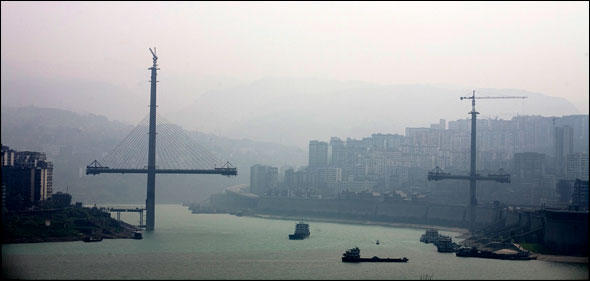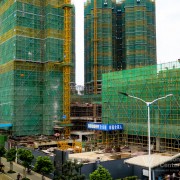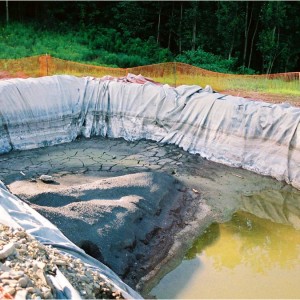More People, More Problems — Water Challenges with Chinese Urbanization
Recent reports reveal the nation’s freshwater challenges and their possible solutions as cities prepare for major influx in population over the next 15 years.
By Brett Walton
Circle of Blue
350 million and 216 — The first figure estimates the number of people who will have moved to a Chinese city between 2005 and 2025, while the second estimates the number of Chinese cities that will have a population greater than one million inhabitants* by 2025, both according to a study by the McKinsey Global Institute.
As the bond between the Chinese economy and the global economy has strengthened over the last three decades, the urban population has gone from 18 percent in 1978 to 46 percent last year, and is expected to rise to 65 percent by 2030. This has coincided with an extension of tap water service from 36 percent of households in 1978 to 94 percent in 2008.
But the continued success of Chinese urban transformation depends on the protection of drinking water sources, according to a new report by Worldwide Fund for Nature (WWF) and the Ministry of Water Resources.
Ma Chaode, director of the WWF China freshwater program, told Circle of Blue that the local, provincial, and central governments are all working to control point and non-point pollution, to plant groundcover, and to protect and restore wetlands. The WWF report also notes that financial and regulatory support from the central government as well as continued institutional development for the river basin management organizations are necessary to ensure ecosystem protection is successful.
Ma added that source protection must be legally mandated to prevent emphasis from being disproportionately placed on massive infrastructure projects–such as the South-North Water Transfer project, a series of pipelines that are thousands of kilometers long and that move water from the Yangtze River to Beijing and the arid northern plains.
“We should focus on an equal footing law,” Ma said, “to balance water source protection with hardware construction.”
In the meantime, payment for ecosystem services (PES) schemes are working well, Ma said. PES entails downstream users, who receive the clean water benefits of upstream healthy forests and wetlands, paying those upstream to maintain the natural capital.
China supports some of the world’s largest PES programs, including the Conversion of Cropland to Forest and Grassland Fund and the Forest Ecosystem Compensation Fund. More than 47 such schemes are active in China, with $US7.8 billion in transactions.
But the current set up–in which the Chinese government shoulders much of the financial burden, with technical assistance from the Asia Development Bank–needs to shift to a user-pays model, Ma said.
The economic efficiency of water, which is the economic output per unit of water, has nearly tripled in the last 25 years. In 1983, the economic efficiency was 28 yuan per cubic meter (about 12 cents per cubic foot) of water, but in 2008 it had risen to 77 yuan per cubic meter (33 cents per cubic foot).
And although residential water use in Chinese urban areas has increased during this time frame–peaking in 2000 at 220 liters (58 gallons) per capita daily, and currently down to 178 liters (47 gallons)–it doesn’t mean that this water is uncontaminated. The Chinese government scores water on a five-point scale. Grades of I and II are acceptable for human consumption, while grade III–which is typically used for fisheries and irrigation–can be potable, if the water is properly treated first. Industry uses water grades of II through IV, but grade V is too polluted to use for anything besides landscape irrigation. According to a 2006 World Bank report, of the nation’s rivers that were monitored for water quality, only 28 percent were above grade II. Additionally, 40 to 60 percent of northern rivers fell into the non-use category.
In 2009, more than a quarter of the water withdrawn for major cities did not meet the water quality standard for drinking water. Today, 25 percent of cities and 70 percent of counties in China do not have sewage treatment facilities, according to State of China’s Cities 2010-2011, a United Nations Habitat report written by Chinese academics. The report, released this month, is a compilation of statistics and a catalogue of urban development practices.
Special economic zones coupled with an export-driven economy have traditionally pushed people to cities in the eastern and southern coastal regions –- the Yangtze River delta, the Pearl River delta, and the Beijing-Tianjin-Hebei triangle.
However, Jennifer Turner, director of the China Environment Forum at the Woodrow Wilson Center in Washington, D.C., told Circle of Blue that the Chinese government is currently promoting economic and urban expansion in other areas of the country. The nation’s “Go West” policy focuses on the city of Xinjiang’s growth and the Three Gorges Dam, which allows tanker ships to access the country’s interior.
***For comparison, Europe currently has 35 cities with a population of greater than one million.
Brett Walton is a Seattle-based reporter for Circle of Blue. Contact Brett Walton
Brett writes about agriculture, energy, infrastructure, and the politics and economics of water in the United States. He also writes the Federal Water Tap, Circle of Blue’s weekly digest of U.S. government water news. He is the winner of two Society of Environmental Journalists reporting awards, one of the top honors in American environmental journalism: first place for explanatory reporting for a series on septic system pollution in the United States(2016) and third place for beat reporting in a small market (2014). He received the Sierra Club’s Distinguished Service Award in 2018. Brett lives in Seattle, where he hikes the mountains and bakes pies. Contact Brett Walton










Leave a Reply
Want to join the discussion?Feel free to contribute!